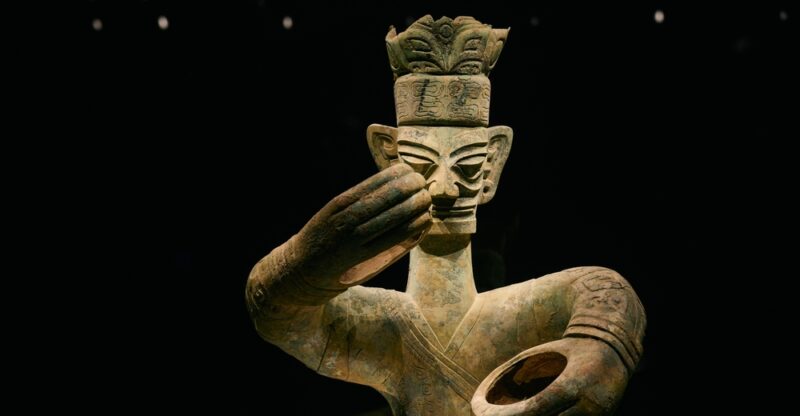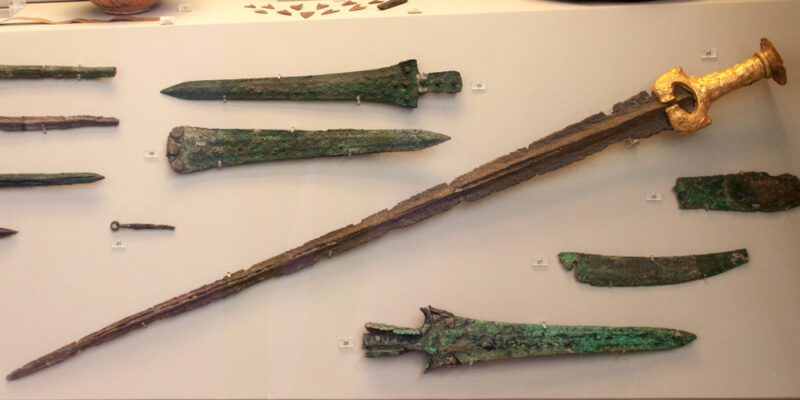We explain what the Bronze Age was, its characteristics and stages. In addition, we explore the earliest civilizations, the end of the period, and more.

What is the Bronze Age?
The Bronze Age is a prehistoric period encompassed within the Metal Ages, situated between the Copper Age and the Iron Age. It began with the discovery of bronze, which resulted from alloying copper with tin, and ended with the introduction of iron as the metal replacing bronze in the manufacture of weapons and tools.
Metal Age dating is used in the study of Asian, European and African populations. Chronologically, the Bronze Age may be placed between 3000 and 800 BC. However, while some cultures developed technologies for metal working and alloying, others did not work metals, but developed other technological advancements. Therefore, the term Metal Age should not be used as a measure of historical progress, but rather as a reference to the development of methods and techniques in handicraft.
During the Bronze Age, the earliest organized states appeared, with larger populations and a more complex and hierarchical social system.
- See also: Prehistory
Characteristics of the Bronze Age
The Bronze Age was characterized by:
- The discovery of metal smelting.
- The formation of highly densely populated societies.
- The emergence of the earliest organized states.
- The earliest complex social structure with class differentiation, comprising the people and the ruling class.
- An increase in warfare, with sophisticated weaponry.
Bronze Age Civilizations
The most prominent civilizations during the Bronze Age were:
Mesopotamia
Around 3000 BC, the Sumerians, inhabiting Asian Mesopotamia, were the first to use bronze for the manufacture of tools, weapons and utensils. Alongside this technological development, they made other technological advancements (such as water canal systems for irrigation), which allowed them to both intensify their agricultural production and create a productive surplus economy.
This process led to social differentiation and stratification, the emergence of privileged social groups, and the concentration of power. Settlements evolved into larger urban centers, with buildings dedicated to specific tasks of craft production, religious worship, and government.
These represented the earliest organized state societies, having a centralized power that monopolized production surpluses, and a privileged social group controlling centralized power. A significant invention linked to state formation was cuneiform script, used mainly to record surplus collection and manage governmental resources.
Prominent cities during this period include the Sumerian city of Uruk, the Akkadian Empire, and the kingdom of Babylon.
Africa
In North Africa, ancient Egyptians began to use bronze as early as 3100 BC. However, the scarcity of the metal in the region meant that stone was not completely replaced as the fundamental material for the manufacture of tools and other handcrafted objects.
Shortly after the discovery of bronze, Egyptian society underwent the same processes of agricultural intensification, social stratification, and power centralization as Sumerian societies. Around 3000 BC, Upper and Lower Egypt were unified under the reign of the First Dynasty.
Far East

The Bronze Age in China began around 1700 BC, and lasted several dynasties for 1,500 years. It might have begun earlier, though ongoing debate regarding the interpretation of archaeological evidence casts doubt on the start of the period.
Bronze in China was used for crafting different types of artifacts for domestic, war, ritual and ceremonial purposes. The three-legged ding cauldrons are particularly renowned. Originally used domestically, over time, they evolved into symbols of state power.
Europe

Pre-Hellenic populations (predecessors of the Greek civilization) inhabited the Cyclades islands in the Aegean, the coastal areas of mainland Greece and the island of Crete. With the development of bronze technology, shipbuilding improved, enhancing the speed and efficiency of maritime vessel travel.
Given the geographical nature of the region, this proved to be a major development. Enhanced navigation led to the colonization of numerous islands and coastal areas, as well as the founding of trading enclaves.
This process enriched some trading groups who, over time, managed to gain dominance and privileges within their communities. The emergence of small independent city-states led to social differentiation, centralization of political power, and appropriation of production surpluses (of the peasants of agrarian communities).
Among the most prominent Aegean civilizations during the Bronze Age were the Minoan civilization (2000-1600 BC), and the Cretan civilization (1600-1200 BC).
In central Europe, bronze was introduced around 1800 BC. The main cultures of the region were the Unetice groups (in present-day Czech Republic, Germany and Poland), the Otomani (in the Balkan region) and, around 1600 BC, the Tumulus culture. These peoples inhabited villages, often fortified with wooden walls.
They exploited the area’s numerous and valuable resources, such as tin, copper and gold mines. They were skilled traders and developed exchange networks that extended as far as the Aegean and the Iberian Peninsula. They used horses and chariots, which gave them great mobility and warfare superiority. However, they did not establish large political units.
Explore next:
References
- Eiroa, J. J. (2003). Nociones de prehistoria general. Grupo Planeta (GBS).
- Alimen, M. H., & Steve, M. J. (Eds.). (1989). Prehistoria (Vol. 1). Siglo XXI. España Editores.
- “Bronze Age”. History.
- “Bronze Age”. Britannica.
Was this information useful to you?
Yes NoThank you for visiting us :)